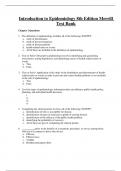Introduction to Epidemiology 8th Edition Merrill Test Bank Chapter 1 Questions 1. The definition of epidemiology includes all of the following, EXCEPT: a. study of determinants. b. study of disease frequency. c. study of disease patterns. d. health -related states or events. e. All of these are included in the definition of epidemiology. 2. True or False? Descriptive epidemiology involves identifying and quantifying associations, testing hypotheses, and identifying causes of health -related states or events. a. True b. False 3. True or False? Application of the study of the distribution and determinants of health - related states or events in order to prevent and control health problems is not included in the role of epidemiology. a. True b. False 4. List four types of epidemiologic information that can influence public health policy, planning, and individual health decisions. i. ii. iii. iv. 5. Completing the clinical picture involves all of the following, EXCEPT: a. identification of who is susceptible for disease. b. identification of types of exposures capable of causing disease. c. identification of the efficacy of the public health problem. d. identifying the probability of recovery. e. All of these are part of completing the clinical picture. 6. refers to the benefits of a treatment, procedure, or service among those who use it in contrast to those who do not. a. Efficacy b. Effectiveness c. Validity d. Healthy participant effect 7. True or False? Epidemiology involves studying only infectious communicable disease, not events like injury, obesity, mental health disorders, seat belt use, etc. a. True b. False 8. We sometimes classify epidemics by how they spread through a population. Which of the following is NOT an example of a point source epidemic? a. Hepatitis B contracted through contaminated water consumed after a football practice b. Salmonella poisoning contracted by a group of family and friends from grandma’s potato salad c. Influenza d. All of these are examples of point source epidemics. 9. Public health surveillance includes all of the following, EXCEPT: a. public health action. b. systematic collection of data. c. analysis of data. d. interpretation and dissemination of data. e. All of these are included in public health surveillance. 10. True or False? A primary case is the same as an index case. a. True b. False 11. In the epidemiology triangle, the term agent is equivalent to which of the following? a. Host b. Pathogen c. Environment d. Field investigator 12. Which of the following best defines a fomite? a. Clothing b. Fly c. Habitat d. Time 13. Humans can serve as all of the following, EXCEPT: a. fomites. b. reservoirs. c. hosts. d. Humans cannot serve as any of these. 14. A subclinical case is the same as which of the following? a. Incubatory carrier b. Intermittent carrier c. Convalescent carrier d. Healthy carrier 15. Which of the following is an example of active primary prevention? a. Screening b. Vitamin -fortified bread c. Immunization d. All of these are correct. For questions 16 –18, refer to the following diagrams: 16. Which of the following is a sufficient cause? a. A b. A, B, C c. A, A, D d. B 17. Which of the following is a necessary cause? a. A b. A, B, C c. A, A, D d. B 18. Which of the following is not a component cause? a. A b. A, B, C c. A, A, D d. B 19. Those diseases and infections that are transmitted between vertebrate animals and humans are referred to as . 20. The second leading cause of death in the United States is . 1 e, 2 b, 3 b, 4 (public health assessment, cause of disease, complete the clinical picture, program evaluation), 5 c, 6 a, 7 b, 8 c, 9 a, 10 b, 11 b, 12 a 13 a, 14 d, 15 c, 16 b, 17 a, 18 d, 19 zoonoses, 20 cancer. Chapter 2 Questions 1. Who introduced the words epidemic and endemic ? a. Hippocrates b. John Graunt c. James Lind d. Thomas Sydenham 2. Who advanced useful treatment and remedies (which other physicians rejected at the time) such as exercise, fresh air, and a healthy diet? a. Hippocrates b. John Graunt c. James Lind d. Thomas Sydenham 3. Who used an experimental study design to determine that dietary factors were influential in treating and preventing scurvy? a. Hippocrates b. John Graunt c. James Lind d. Thomas Sydenham 4. In the 1700s, it was observed that armies lost more men by dis ease than by the sword. James Lind focused on illnesses in populations. He observed the effect of , , , and on the spread of disease. 5. The Chinese observed that getting a weaker strain of smallpox was protective against encountering a stronger form of the diseases. What is this called? a. Immunity b. Herd immunity c. Variolation d. Virulence 6. Who invented a vaccine against smallpox based on careful observation? a. Benjamin Jesty b. Edward Jenner c. Louis Pasteur d. Robert Koch




